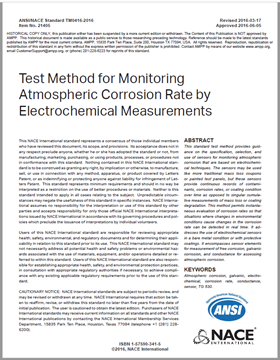Search
Products tagged with 'test methods'
View as
Sort by
Display
per page
51318-11204-Nondestructive Evaluation for Yield Strength and Toughness of Steel Pipelines
Product Number:
51318-11204-SG
Publication Date:
2018
$20.00
A Comparative Study Of DLEPR Techniques For Cast Austenitic Stainless Steel
Product Number:
51321-16447-SG
Publication Date:
2021
$20.00
An Overview of Significant Updates to High Voltage Holiday Detection Standards (NACE SP0188/SP0274/SP0490, ASTM D5612/G62, ISO 29601)
Product Number:
51324-21164-SG
Publication Date:
2024
$40.00
ANSI/NACE TM0284-2016, Evaluation of Pipeline and Pressure Vessel Steels for Resistance to Hydrogen-Induced Cracking
Product Number:
21215-SG
ISBN:
1-57590-163-3
Publication Date:
2016
$109.00
ANSI/NACE TM0416-2016, “Test Method for Monitoring Atmospheric Corrosion Rate by Electrochemical Measurements”
Product Number:
21405-SG
Publication Date:
2016
$179.00
Applying Common Sense to Moisture Vapor Emissions and Moisture Content Test Requirements When Coating Below Grade Concrete Structures in Wastewater Applications
Product Number:
41216-989-SG
Publication Date:
2016
$20.00
Are you Ready to Pursue Today’s Greatest Market Opportunity In the Coatings Industry? Millions of Square Feet of Commercial Walls Need Air Barriers. What do you Need to Know to be a Part of this Emerging Market?
Product Number:
41216-957-SG
Publication Date:
2016
$20.00
Cathodic Protection Survey Procedures, 3rd Edition
Product Number:
37614-pdf
ISBN:
978-1-57590-454-2
Publication Date:
3rd
$137.00
Cathodic Protection Survey Procedures, 3rd Edition
Product Number:
37614
ISBN:
978-1-57590-332-3
Publication Date:
2016
$130.00
Cathodic Protection Survey Procedures, 3rd Edition (e-book)
Product Number:
37614-E
ISBN:
978-1-57590-332-3
Publication Date:
2016
$137.00
Challenges and Insights behind Qualifying a Protective Coating as a Corrosion under Insulation Preventive Coating
Product Number:
51324-20774-SG
Publication Date:
2024
$40.00












